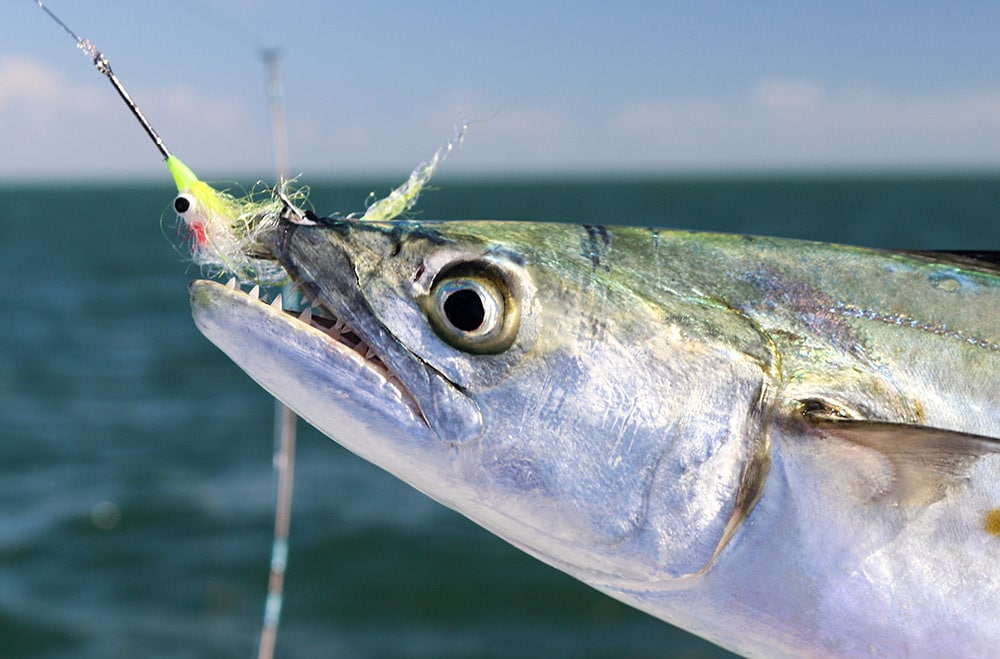
Cruising along at planing speed, I scanned the horizon in Florida Bay for signs of feeding activity. It was a calm winter day, and a strong cold front had put a nip in the air, which we hoped would turn on the Spanish mackerel bite. We were southwest of the Everglades National Park boundary, in good mackerel territory: 6 to 8 feet of water over patches of thick turtle and manatee grass, with the occasional white sandy pothole, when I spied birds hovering over the surface, in the distance. As we approched, a pack of panicked, small ballyhoo tail-walked across the surface, right off our bow, a promising omen.
“Get a whiff of that,” I said to my buddy Richard Kernish. “Who opened a can of sardines?” he replied, as the strong smell of baitfish hit us like a punch to the face. Coming off plane, we spotted small baits dimpling the surface all around us. We could still make out the bottom clearly, and the current was cranking, so we knew this was the place to set up. Richard quickly fetched a block of blood chum from the cooler, and hung it in a mesh bag over the side. I un-racked a couple of fly rods from one of the gunwales, then scooped a couple gallons of water into a 5-gallon bucket to thaw out glass minnows to spice up our chum line.
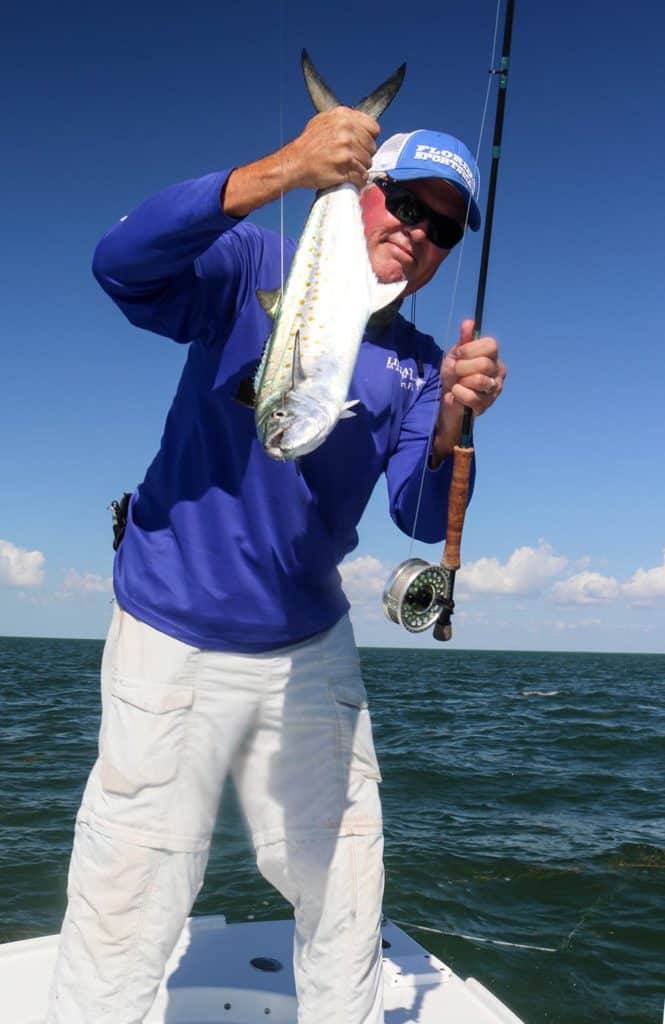
In the brisk current, an oily slick lengthened off the stern within 5 minutes. A cloud of pinfish rose from their grassy refuge to pick off chum bits, and more juvenile ballyhoo soon swarmed in. Everything was shaping up nicely. Richard grabbed a spinning rod and I reached for an 8-weight with a clear monocore line. My fly choice was a long-shank, chartreuse-and-white Clouser Minnow. I cast 40 feet of line and leader and shook, and aided by the pull of the current, let additional loose line from the deck slide through the guides so the fly could drift farther back into the chumslick.
“The place is like a food truck festival, hope the macks like variety,” I said, as I tossed a handful of thawed minnows back in the slick. Suddenly, the cloud of ravenous pinfish vanished, and seconds later, three green missiles screamed through the chum line, announcing Spanish mackerel had arrived. from the right.
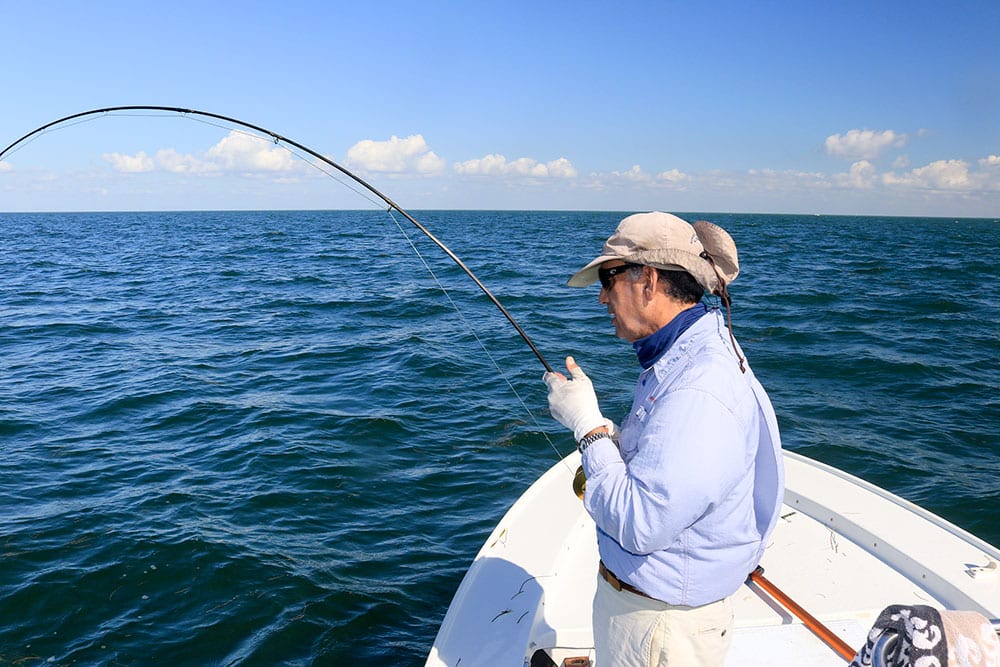
“We have customers,” I said, immediately making a roll cast that shott my fly 60 feet astern. He had a strike and missed the hookup, but kept jigging and his rod again bent deeply. After a couple of head shakes the mack ran against his drag. I stripped my fly swiftly, and the moment it came into view, I spotted two husky Spanish macks in hot pursuit. They suddenly turned away, so I made another cast, let the fly sink, and a fish picked it up before I had the chance to strip again.
The instant I came tight, the mackerel took off, taking my entire fly line along on a blistering run. The fish then reversed course, coming straight back at the boat. I reeled like crazy to keep pace and gain control, and a few minutes later landed a solid 3-pounder that kick-started two hours of nonstop action, during which Richard and I landed over a a dozen mackerel of similar size, until the current slowed down.
Spanish Strongholds
The described mackerel action took place in Florida Bay — the body of water between the Upper Florida Keys and the Everglades — in late February, about the peak of the Spanish migration in South Florida. The fish arrive there by late October, then, as the water temperature rises (Spanish mackerel prefer water above 70 degrees), they head back north along Florida’s Gulf Coast by late April or early May. So fly fishers get to target those northbound fish throughout the summer, as they make their way up toward the Florida Panhandle.
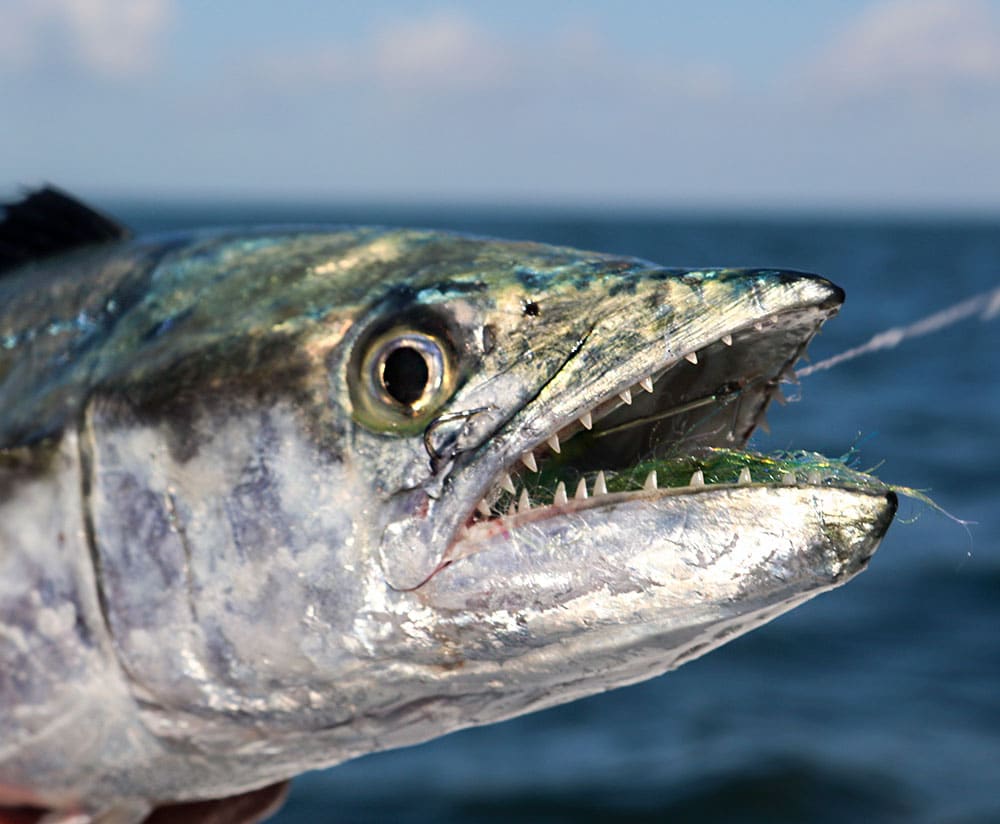
Roughly from May forward, Spanish mackerel congregate along the central Gulf of Mexico coast, from Alabama to south Texas, with peak fishing takeing place from June through late September. The fish hug the beaches in that region, and calm seas that time of year enable fly fishers to target them from small boats and sometimes even kayaks.
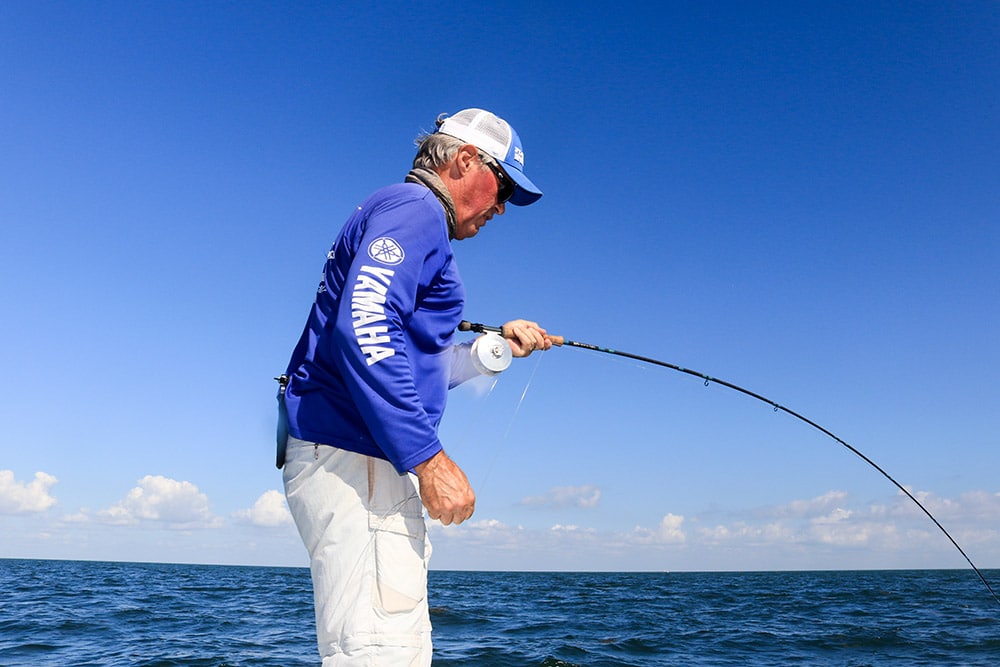
Teeming with baitfish, Louisiana’s nearshore oil rigs are terrific Spanish hangouts. In Texas, surf anglers take most mackerel as they chase baitfish along the guts close to shore, in late summer and fall. A fly fisher with a stripping basket can do very well in the surf, and that includes fishing from the jetties that pepper the Lone Star State’s coastline.
On the Atlantic coast, Spanish are strictly a summer and early fall catch north of Florida. But they usually invade Florida waters in early December, with the bulk of the stocks staging anywhere between Fort Pierce and the Upper Keys. Most fish patrol the beaches, but many also enter the inlets and rove along the Intracoastal Waterway.
Although Spanish mackerel are migratory fish, large schools occasionally hang out in inlets, or just offshore, to feast on the forage that moves in and out with the tides. Jetties, piers, and bridges over inlets are natural magnets for baitfish, shrimp, and predators like Spanish mackerel.
Forage and Telltale Signs
Spanish mackerel feed primarily on schooling baitfish of all types: glass minnows, bay anchovies, sardines, finger mullet and others. The presence of bait schools usually attracks birds, which can be spotted — hovering and occasionally dipping toward the surface — from a distance. And bird activity increases when mackerel are feeding. So a group of gulls, terns or pelicans diving, or just sitting on the water, anywhere from the swash zone of the surf out to nearshore reefs, is worth checking out.
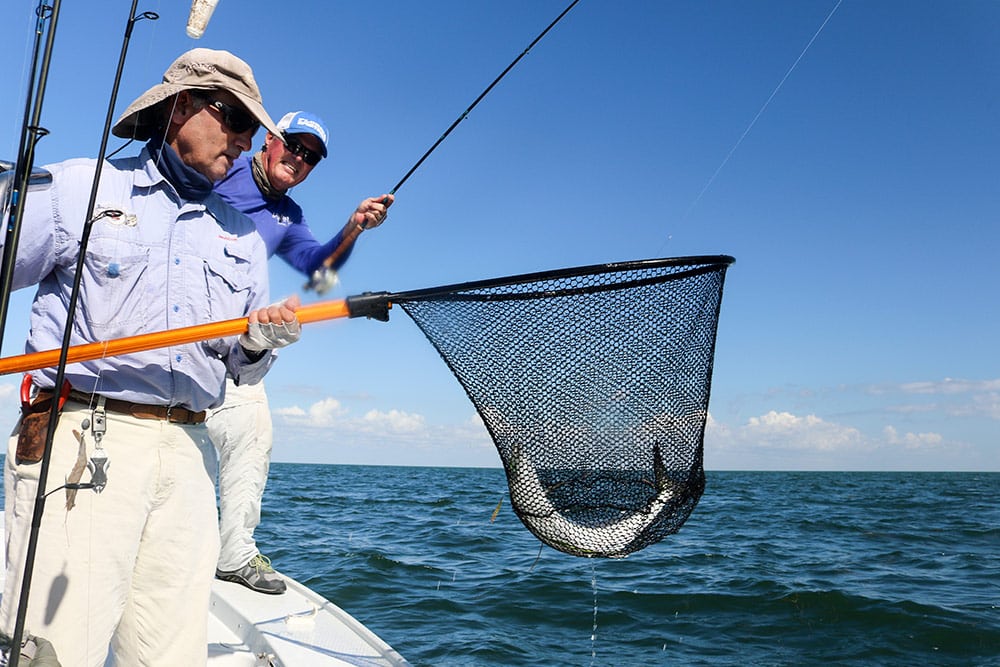
A fleet of boats closely gathered in one area is another obvious signs. Oily slicks are created by baitfish and feeding activity, too. So it pays to blind-cast around such spots. And keep an eye on packs of dolphin. They eat mackerel, and often round them up by circling and periodically slapping the surface loudly with their tails.
Fly rodders also score from the beach, most frequently near an inlet or pass, on calm days when the fish are hunting the trough, smack against the sand.
Chum, which attracks both baitfish and predators, greatly increases your chances, but it isn’t required when Spanish school up en masse, as they often do in places like Peck Lake, a nearshore reef south of Southeast Florida’s St. Lucie Inlet.
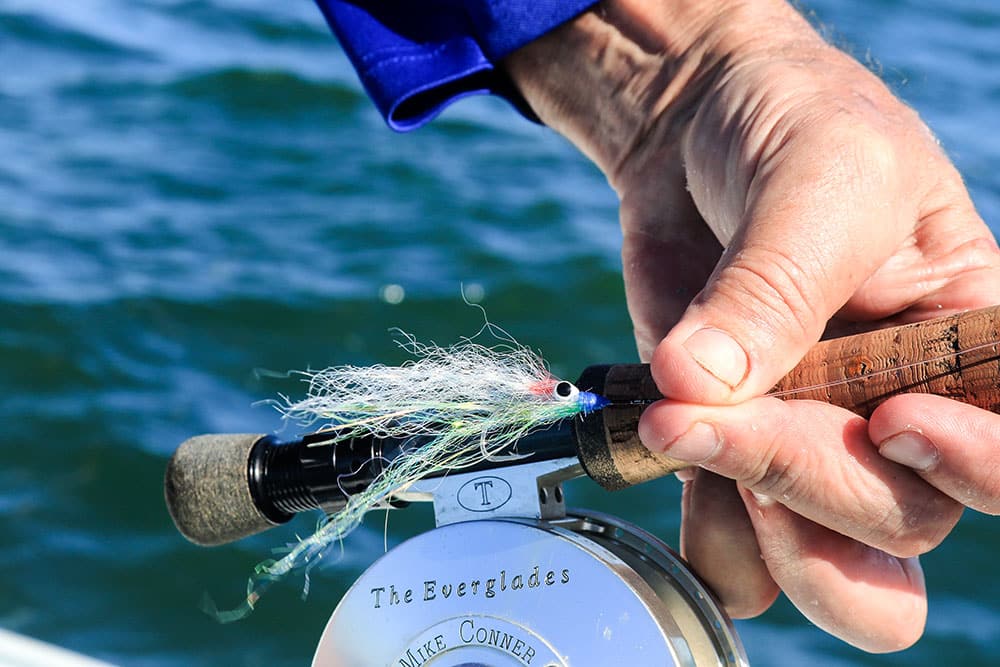
One fly outfit was rigged with a floating line and a small Mylar popper, the rest with slow-sinking lines and streamers. We also had a couple of spinning outfits with Mylar jigs for prospecting.
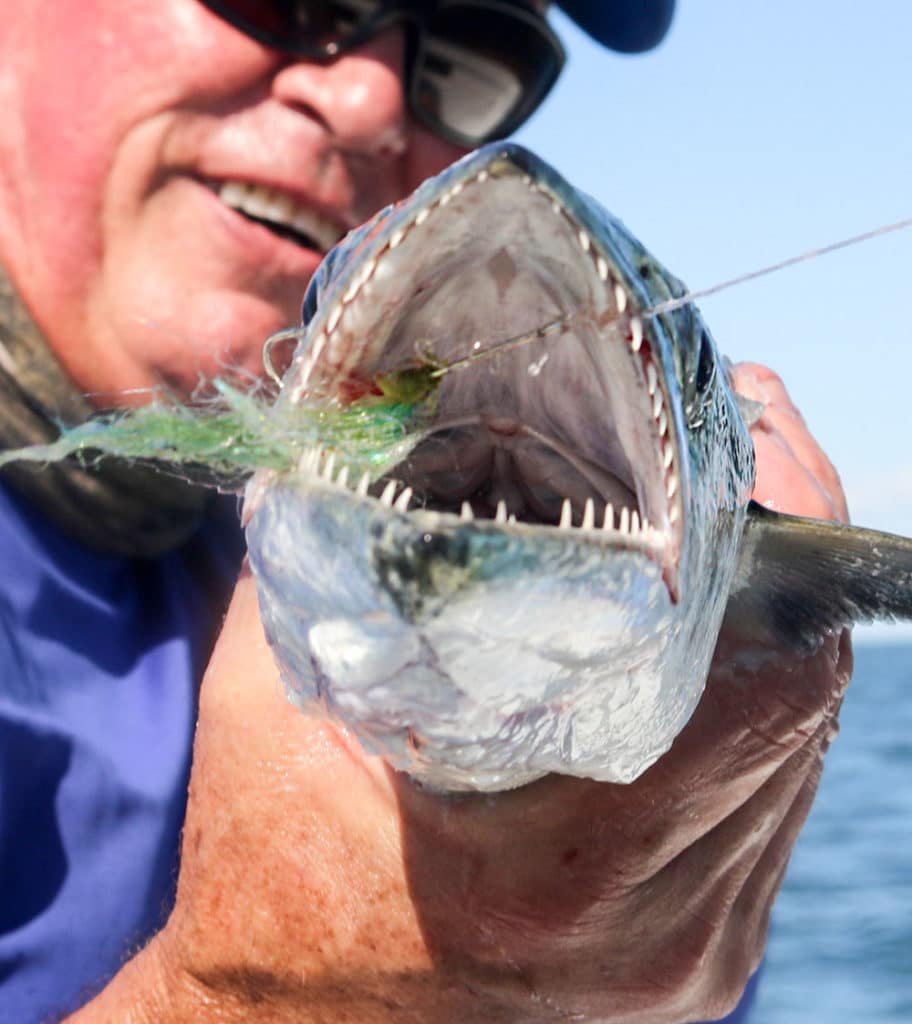
Fly rods in the 6- to 9-weight class are ideal for Spanish mackerel, and anglers should primarily consider fly size and weight, rather than the target fish’s size, to determine which rod to use. When fish are holding deeper in the water column, it’s better to fish sink-tip or full sinking fly lines. But if a floating line is all you have, just fish heavier flies to get down to the fish. However, if there is floating grass on top, a floating line tends to funnel that grass down to the leader and foul the fly. In my opinion, an intermediate-sink line (clear or opaque) is the most utilitarian of all, followed by a slightly more dense sinking line that drops 2 or 3 inches per second.
Feeding mackerel are rarely put off by a fly line, so leaders can be short. With sinking lines, I loop on a 3- to 5-footer. Unless looking to break class-tippet records, you can just fish a straight piece of 40- to 60-pound mono or fluorocarbon. Otherwise, a class tippet of 12- to 20-pound-test tied to a 40- to 60-pound bite tippet is ideal.
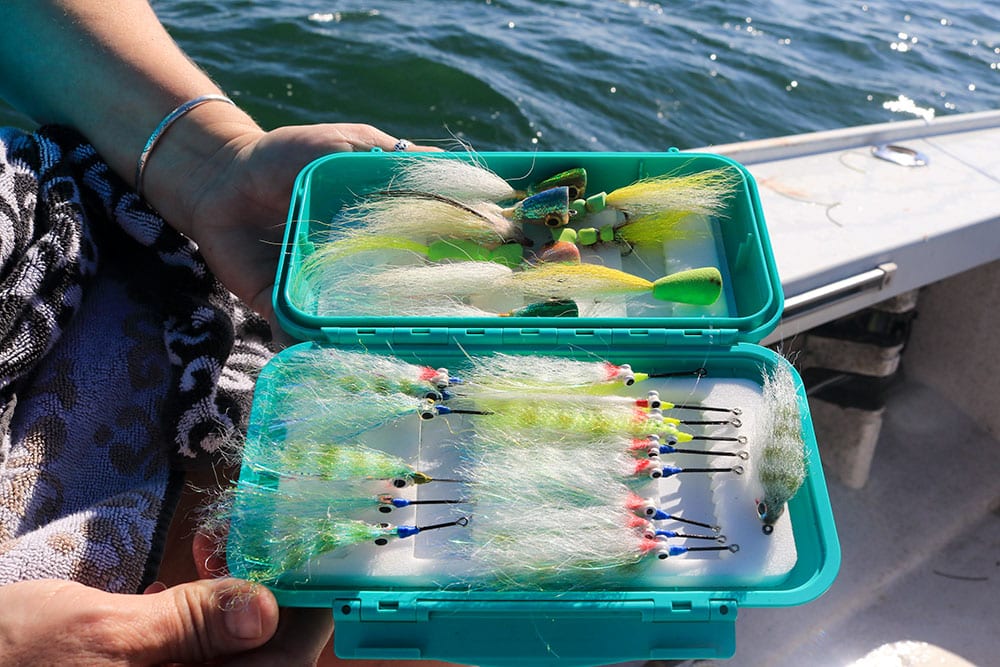
In muddy or stained water, you can often get away with fishing a light wire bite tippet. And in a chum line, when the fish are super aggressive, they don’t seem to mind the wire either, even in clear water. Choose between single-strand and one of several knottable-wire materials now available. If you opt for single-strand wire, attach it to your class tippet with a haywire twist. The knottable stuff is more supple and can be connected with any conventional knot of your choice. In either case, keep wire bite tippets short —about 3 inches, so they don’t hinder casting. Go a bit longer with mono or flourocarbon. The sharp teeth of mackerel fray such materials badly, so the longer length allows you to retie several times before having to replace the tippet.
Best Flies and Presentation
Spanish mackerel typically eat anything that won’t eat them first, and their aggressive nature offers a terrific chance to bring your old, ratty-looking flies out of retirement. Basic white and flashy baitfish patterns are the best choices for Spanish mackerel. Clouser Minnows, Epoxy Minnows, Mylar Minnows, Deceivers, Bendbacks (especially where floating grass is present), Gurglers and other poppers all work. Chartreuse is always a good color, and sometimes a hot-pink pattern turns mackerel on. Liberal amounts of flash material helps, especially in turbid water, and standard hook sizes range from 2 to 1/0.
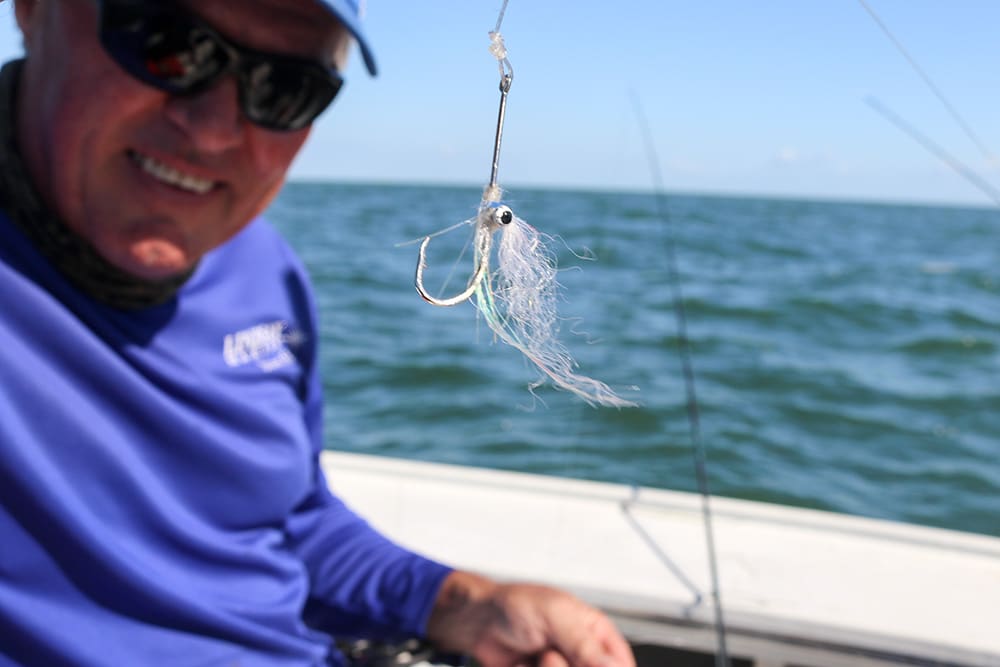
For mackerel, fast, erratic stripping usually seals the deal. Now and then, you can also swim a fly steadily with long draws of the line, or simply allow the fly to drift back in the chum line. The fish take it as it sinks. Poppers are excellent for drawing the attention of the fish. Big mackerel, in particular, relish a popper, and surprisingly many strikes come when the popper is at rest. Some of my biggest macks, 5- to 6-pounders, skyrocketed on my popper as it bobbed along when I had stopped stripping.









